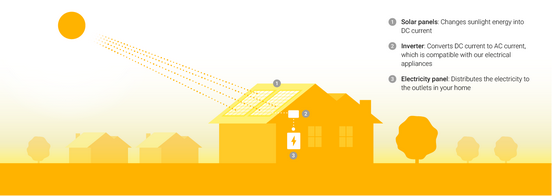The rise of solar energy use, especially by homes and businesses with panels on their roofs, is gradually transforming the electricity industry. But solar installers in the United States face a challenge in finding new customers at reasonable customer acquisition costs in order to fuel their growth. And many potential customers are confused about how solar power works, creating a barrier to its adoption.
Last year, Google introduced Project Sunroof to enable tens of millions of potential solar customers from across the U.S. to evaluate if their home is suitable for solar and how much they could save on electricity.
Project Sunroof works by using high-resolution aerial imagery from Google Earth to help calculate a roof’s solar energy potential. Users simply need to enter their address, and in roughly one second the technology analyzes factors such as shade, roof orientation and local weather patterns to calculate how many hours of sunlight hit that roof in a typical year. All of this information is combined to create an estimate for how much power a user could produce, and estimated savings with solar. For users looking to take the next steps in going solar, Project Sunroof makes it easy by enabling users to connect and share their information with local providers they select.
Project Sunroof is enabling more rooftop solar installations, allowing individuals to save on their electricity bills while helping the environment by reducing greenhouse gas emissions. Furthermore, by accelerating the growth of solar, Sunroof is helping solar installers expand more quickly, attracting more capital and enabling further growth.
Key facts
- Project Sunroof has demonstrated its scalability by expanding from 2 states (and 1.4 million buildings) to 42 states (and 43.4 million buildings) in roughly 8 months.
- Project Sunroof currently works with more than 40 solar installers across the U.S., a number it expects to expand rapidly over the coming months.
The problem
As the price of installing solar has gotten less expensive, more homeowners are turning to it as a possible option for decreasing their energy bill. However, the process of installing solar is not easy to understand for the average person. Many people are unsure about solar power, from the basics of how solar works, to knowing whether their roof is viable, to the process of getting solar, and to how to pick the right solar installer.
As Project Sunroof reaches more and more users in a wide variety of geographies, it will be helping build widespread knowledge and acceptance of solar power, breaking down barriers to solar adoption, and accelerating the growth of a source of clean and affordable energy.
The solution
Project Sunroof maps the solar potential of homes in 42 states in the United States, providing detailed, customized estimates of solar savings to its users. The product uses unique Google mapping technology to build 3D models of each home and surrounding objects, enabling accurate calculation of shade and energy production on a user's roof.
When a potential customer enters their address, Project Sunroof looks up their home in Google Maps and combines that information with other databases to create a personalized roof analysis.
The calculations also incorporate local weather patterns, local electricity prices, the price of solar, relevant solar incentives, solar financing options and more to generate a comprehensive estimate of energy production and solar savings potential.
Project Sunroof aims to accelerate the growth of solar by primarily by empowering users with information and making it easy to combine a complex set of factors into a clear and simple bottom line about the potential of solar for their situation, while making it easy to connect with solar installers to get a detailed proposal and ultimately put solar on their rooftop.
Helping the planet
 Project Sunroof’s goal is to accelerate the growth of solar power. The expansion of solar power in the electricity mix will help mitigate carbon emissions from the power sector, reducing the amount of greenhouse gases released into the Earth's atmosphere.
Project Sunroof’s goal is to accelerate the growth of solar power. The expansion of solar power in the electricity mix will help mitigate carbon emissions from the power sector, reducing the amount of greenhouse gases released into the Earth's atmosphere.
Helping people
By helping individuals take action on climate change by adopting solar power for their homes, Project Sunroof is empowering concerned citizens to make a difference. Sunroof has connected thousands of users with solar installers to help them go solar, and those numbers will continue to grow over time.
Once a user understands solar power, understands the process for buying solar, and has a trustworthy and unbiased and accurate estimate of their potential to save money with solar on their own roof, many of the barriers to taking action have fallen away, and the user can confidently move forward in the solar buying process.
With Google's imagery data, 3D algorithms, machine learning and datacenter capacity, users no longer have to set up an appointment with a solar installer to inspect their house in person in order to see if solar could be right for them. Project Sunroof puts that information a few clicks away, and does so with a combination of large scale and a high degree of accuracy.
Solar installers in the U.S. face a challenge in finding new customers at reasonable customer acquisition costs in order to fuel their growth. Sunroof helps them find new potential customers, who after using Sunroof are already fairly advanced in their understanding of solar power, and thus more likely to go solar. Project Sunroof has been in constant consultation with leading solar installers in the U.S. to understand their needs and to learn from their extensive experience.
Sunroof users connect with these installers to get a detailed solar quote and move forward in the installation process.
Building customer awareness and making it easy to take action are critical steps in enabling the rapid growth of rooftop solar, which is itself a critical element of a low carbon or zero carbon future.
Spillover effect
After launching in 2 states in August 2015, Project Sunroof has quickly expanded, hitting 10 states in December 2015, and recently expanding to 42 states in April 2016, with continued expansion expected in the coming year.
Project Sunroof has demonstrated its scalability by expanding from 2 states (and 1.4 million buildings) to 42 states (and 43.4 million buildings) in roughly 8 months, and there is every reason to believe that the expansion to new geographies can continue both within the U.S. and outside the U.S. as well.
Project Sunroof has the ability to expand to any geography where Google has access to a few key inputs: high resolution aerial imagery, local weather and electricity rate data, and data on solar prices and incentives.




Images owned by the activity partners, all rights reserved.

